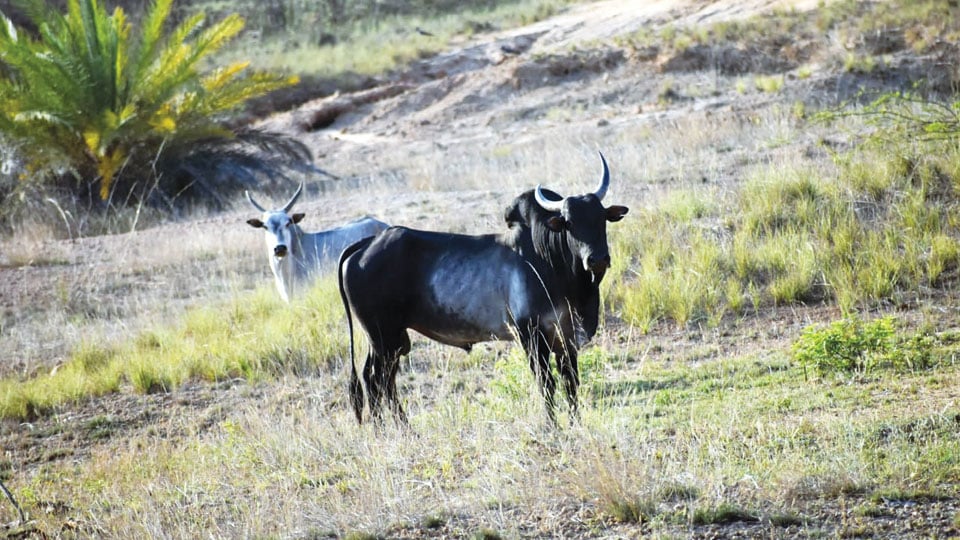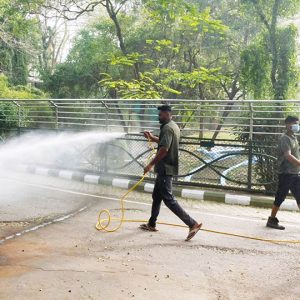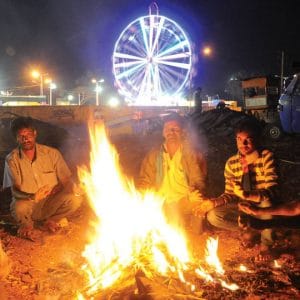Untold story of untamed cows and bulls at Ranganathittu’s Goolithittu Island No. 25
By M.T. Yogesh Kumar
In the realm of wildlife, countless wonders remain shrouded in mystery, far from human understanding. Among these, the enigmatic existence of wild cattle stands out — a quiet kingdom of its own. In Srirangapatna, this rare and unique cattle community thrives, captivating those who witness it.
Globally, only a handful of places have seen wild cattle establish their dominion. One such extraordinary location is the Ranganathittu Bird Sanctuary in Mandya district’s Srirangapatna taluk.
Of particular fascination is Island No. 25 within the Sanctuary, a site that has piqued interest. Known primarily as a haven for migratory birds, the sanctuary boasts over 40 bird species in addition to scores of migratory bird species and teems with hundreds of crocodiles. Tourists often embark on boat safaris, marvelling at the birds nesting on these islands, creating memories of a lifetime.
Amidst this vibrant ecosystem lies the age-old kingdom of wild cows and bulls, a legacy believed by locals to span centuries. This unassuming island, nestled in the heart of the sanctuary, is a testament to nature’s ability to preserve its wonders in harmony with time.

Goolithittu
Just beyond the usual boat safari route, along the Cauvery River, lies a remarkable sight — a vast island that captivates the imagination of visitors. This is Goolithittu, an island where wild cattle have carved out a unique existence, leaving the civilised world in awe.
Spanning an impressive 66.6 acres, Goolithittu is the largest island within the sanctuary. Its enigmatic charm, coupled with its role as the kingdom of wild cattle, sets it apart as one of the sanctuary’s most intriguing features.

Origin of wild cattle
More than 200 years ago, the area surrounding the Ranganathittu Bird Sanctuary was dotted with small villages, where people lived in modest huts and houses. However, the deadly outbreaks of infectious diseases like plague and cholera struck these small villages, leading to numerous fatalities.
Overwhelmed by fear, the villagers abandoned their homes, leaving behind not only their belongings but also their livestock. These abandoned livestock gradually adapted to the island’s environment.
Over generations, these domesticated animals transformed into what we now recognise as wild cattle, creating a thriving, self-sustaining population and establishing a unique natural legacy on the Goolithittu Island.
Footsteps of Mysore royalty
The areas of present Goolithittu was once a small village steeped in history. In the days before the construction of the Krishna Raja Sagar (KRS) Dam, River Cauvery (Kaveri) flowed freely and unobstructed, sparing the village from harm.
Legends indicate that Mysore royal families visited this serene island to revel in its natural beauty. To accommodate their visits, a charming house was constructed, along with a tree-top watchtower that provided a panoramic view of the bird colonies and the surrounding landscapes. This tower allowed the royal visitors to experience the island’s unique environment from a breathtaking vantage point, leaving behind a legacy that still lingers.
Decades ago, a devastating flood swept away much of Goolithittu Island’s history. The house built for Mysore royalty, the tree-top watchtower and the villagers’ huts were all lost to the rising waters. Yet, the foundation of the royal residence endures as a silent marker of the island’s regal past.

Crocodile Park plan
Goolithittu was at the centre of an ambitious plan by the Forest Department around a decade ago with a proposal to establish a crocodile park on the island. The plan involved constructing a large pond and relocating some of over 200 crocodiles from river to this enclosure. However, the project never materialised, allowing Goolithittu to retain its natural environment — continuing to thrive as a unique sanctuary for wild cows and bulls.
From 100s to 21: The decline
Goolithittu, once a thriving haven for over a hundred wild cattle, now faces a sharp decline in population. These animals, which established their unique kingdom over centuries without human interference, have dwindled to just 21.
The primary threat is leopards that prey on their calves, steadily reducing their numbers. Immediate measures are essential to safeguard the progeny of Goolithittu’s wild cattle.
Research into the lifestyle and characteristics of this pure native breed is crucial to ensure their survival.
As Goolithittu lies within a protected forest area with restricted public entry, the absence of human activity has allowed these animals to live freely. However, this very isolation makes them vulnerable to natural predators, underscoring the urgent need for conservation efforts to preserve this unique legacy.

Shy yet strong
The wild cattle and calves of Goolithittu have thrived without human intervention, forming their own unique lineage and way of life. These majestic creatures, known for their towering stature and robust build, are as beautiful as they are elusive.
Shy by nature, they flee at the slightest glimpse of humans. Without the restraints of ropes or nose rings, their wild spirit shines through as they glare at onlookers, giving the impression of an impending attack. But they vanish with remarkable speed.
About 10-15 years ago, efforts were made to relocate the wild cattle to a safer environment. The plan involved fencing and placing stone pillars around a designated area to capture them. However, these resilient animals shattered the stone pillars with their power, making the relocation attempt futile.
Locals attribute the survival of these wild cattle to the blessings of Lord Ranganathaswamy, the presiding deity of Srirangapatna. They also claim that every attempt to capture or relocate these animals has met with failure, reinforcing the mysterious and enduring legacy of Goolithittu Island’s wild cattle.
The world of wild cattle: A rare legacy
This phenomenon of wild cattle is not limited to Karnataka. In Odisha’s Hirakud forest area, wild cattle have thrived for the past 65 years. Their origin dates back to 1950, when the construction of a dam on the Mahanadi River submerged 141 villages in Odisha and 33 villages in Chhattisgarh.
The villagers abandoned their livestock, which adapted to the wild and gave rise to a lineage of wild cattle that persists even today. Beyond India, there is also an island in America where wild cattle have made their home, underscoring the rarity and resilience of these unique herds.








Recent Comments